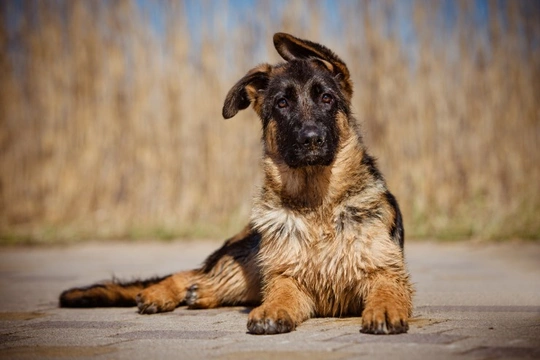
What can you do if your German shepherd puppy’s ears don’t stand up?
When it comes to dogs and their ears, they certainly come in all shapes and sizes from long and drooping to petite and pointed, and for pedigree breeds, the position their ears should take when they are fully grown is usually dictated in the breed standard. For German Shepherds, the breed standard dictates that the dog’s ears should be proud and erect in the adult dog – but most of us have seen a German shepherd puppy with floppy ears, or even one ear up and one down as they develop!
Some German shepherds will retain drooping ears into adulthood, and whilst having floppy ears isn’t generally a problem for the dog itself, it is classed as a fault in the dog’s conformation – and whilst this is of no importance to many owners, it is wise to know why the dog’s ears may not become erect, and if anything can be done about it.
In this article we will look at how, when and why the German shepherd’s ears begin to stand up, what can cause floppy ears, and how to help to ensure that you puppy’s ears stand up naturally. Read on to learn more.
The German shepherd puppy
German shepherds aren’t born with erect ears – pups of the breed have floppy ears at birth, which will only begin to point when the dog reaches around four to five months old at the earliest, and sometimes a couple of months later.
This is because when puppies are born, their ears aren’t fully developed and they can’t even hear, and as the pups begin to open their eyes for the first time at a couple of weeks old, so too will the dog’s ears begin to function and allow them to hear their first sounds.
However, even after this point, the ears will continue to develop for some time, forming the necessary cartilage to allow the ears to mature and in breeds like the German shepherd that have pointed ears, begin to support the ears in standing up.
If your pup’s ears are still floppy and show no signs of beginning to stand up by the time the dog is around eight months old, it may mean that it isn’t going to happen – but you may be able to help to support your pup to ensure that it does.
Can you tell if the ears are going to stand up ahead of time?
It’s not really possible to tell if your pup’s ears will stand up when they are mature until they are at least a few months old, as this time is necessary to allow the firm cartilage in the ears to develop enough to support them. However, pups don’t simply go from being floppy eared to having pointed ears overnight, and your pup’s range of mobility and ability to control the movement of their ears develops over time.
If your pup can prick their ears up or if the tips of them are very mobile by four to five months old, the chances are that their ears are developing normally, and will become pointed at the normal time without any intervention. If your pup’s ears have not begun to do this by the time they are around eight months old, it might not be going to happen.
Why might a German shepherd’s ears not stand up?
If your pup’s parents didn’t both have normal, pointed ears, the chances are greater that your pup won’t either, although dogs without pointed ears are not commonly used for breeding, as this trait falls outside of the desirable breed standard. However, if your dog doesn’t have pedigree papers or isn’t a purebred German shepherd, even if they look very much like one, the chances of their ears being floppy is a little higher due to the potential for mixed parentage, or breeding lower quality dogs outside of the breed standard.
However, the issue can arise in any German shepherd puppy, regardless of their ancestry, and if your pup is one of those with floppy ears, there are a few things that can cause or contribute to why this happens.
Calcium and vitamin D are both essential elements for the nutrition and growth of a puppy, and both of these things are required in order to support the development of the ear cartilage that ultimately, leads to the dog’s ears standing up.
Supplementing your pup’s diet with a little extra calcium-rich food whilst they are young can help to ensure that the ears will stand erect later on as they are supposed to, as this helps to contribute to the necessary cartilage development of the ears.
It is also of course important to ensure that your pup has a balanced diet and gets all of the other nutrients that they need while they are still growing and developing, which reduces the chances of developmental problems later on.
Additionally, the developing cartilage itself is rather fragile until it is fully formed, which means that too much massaging and rubbing of the ears while they are forming – and rowdy behaviour by other dogs, such as tugging on the ears or otherwise pulling them around – can also lead to problems achieving pointed ears in the adult dog, which is something else to be aware of.
Ultimately, a German shepherd with floppy ears might fall outside of the breed standard, but unless you had plans to breed from them, there will be no other impact on yourself of your dog’s life – so if your pup’s ears don’t stand up, don’t worry about it.



